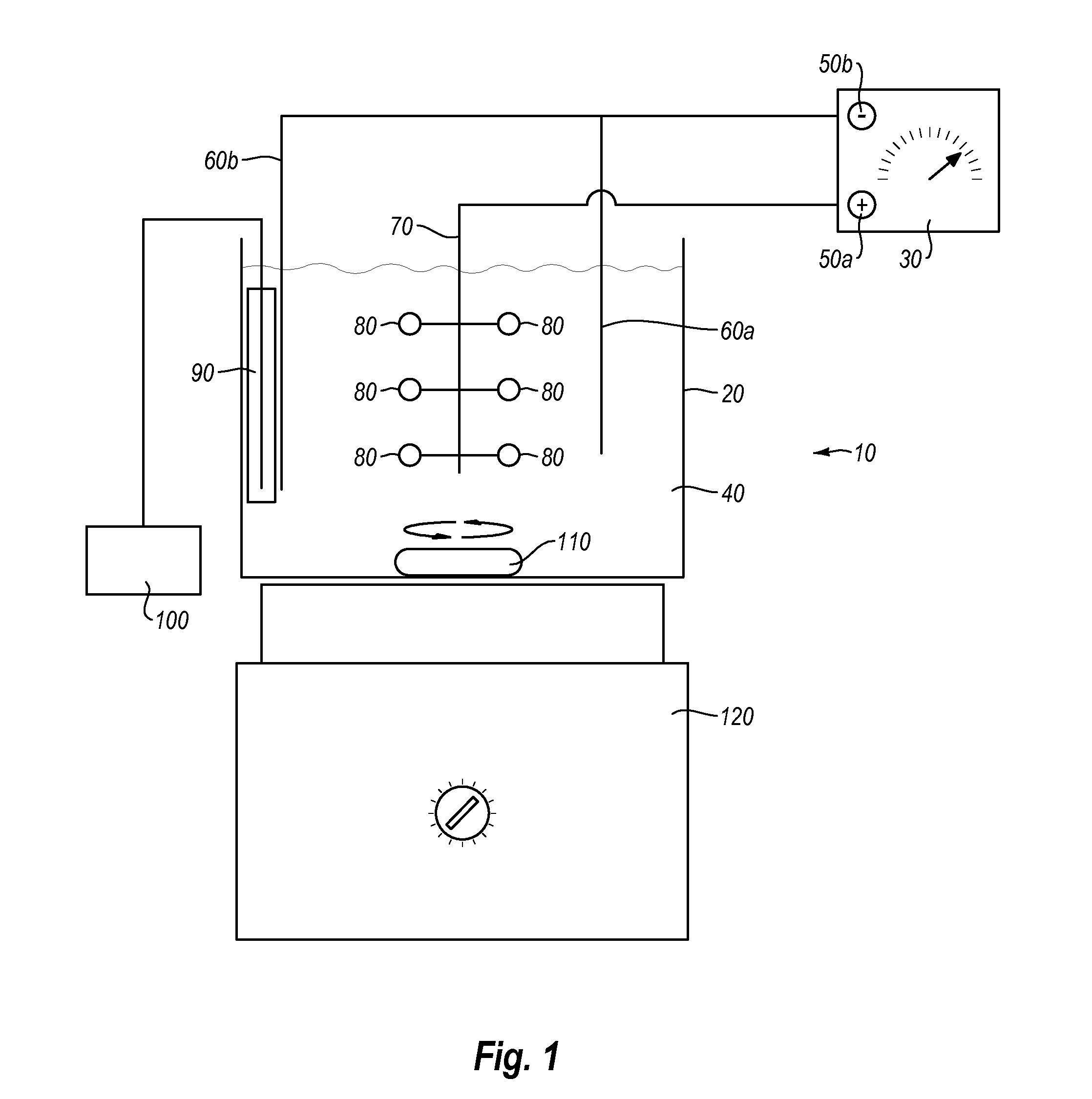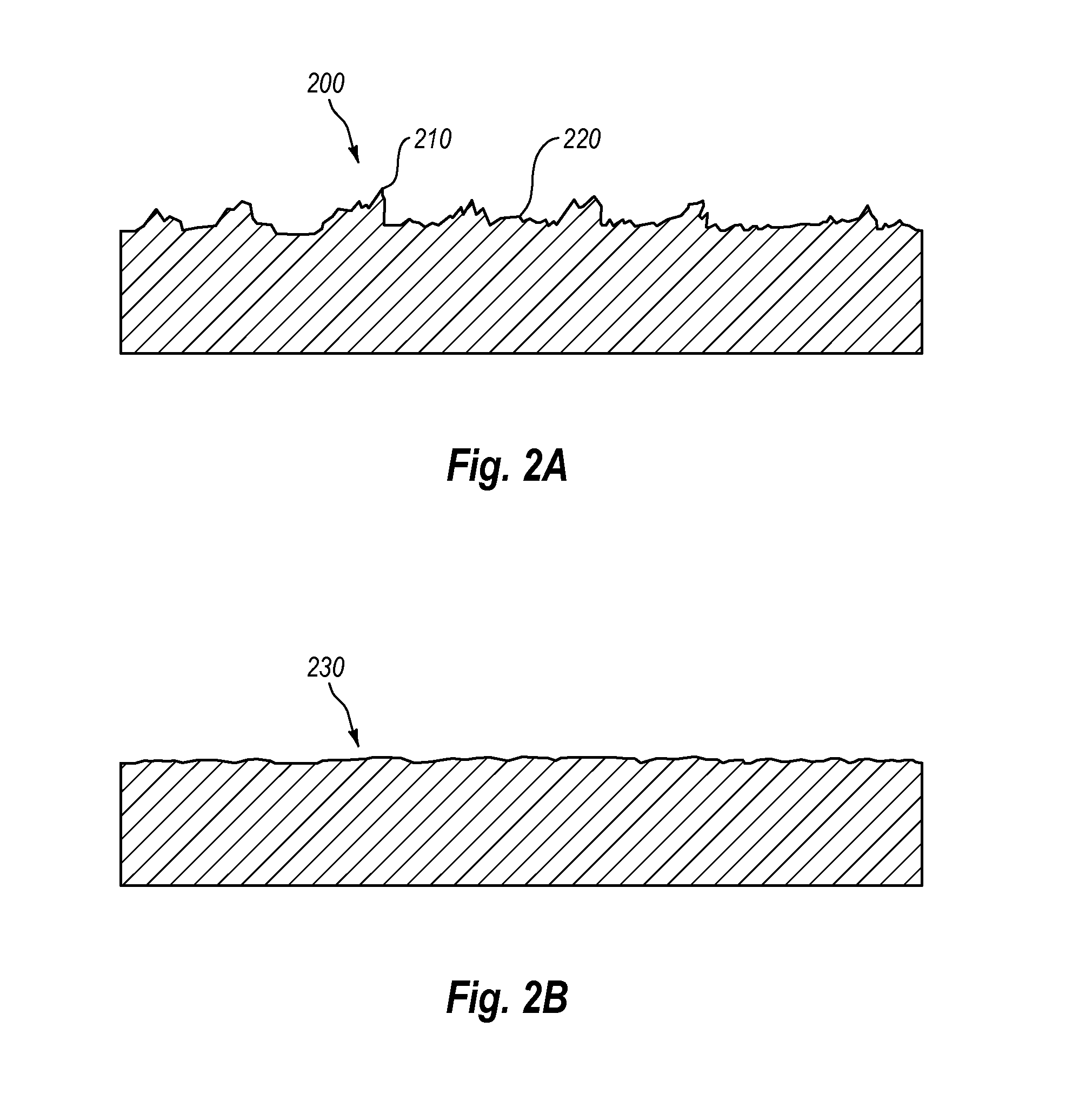Electropolishing solution containing a water sequestering agent and methods of use thereof
a technology of electrolyte solution and water sequestering agent, which is applied in the field of electrolyte solution, can solve the problems of affecting the surface quality of the electrolyte solution, gas bubbles, and substantially anhydrous electrolyte solution, and achieves the effects of improving surface quality and uniformity, improving electrolyte efficiency, and increasing longevity of electrolyte solution
- Summary
- Abstract
- Description
- Claims
- Application Information
AI Technical Summary
Benefits of technology
Problems solved by technology
Method used
Image
Examples
working example 1
[0062]An electropolishing electrolyte solution may be prepared in the following manner:
[0063]1. Turn on chiller, wait until temperature is below 0° C.
[0064]2. Cool methanol at least 3 hours prior to mixing.
[0065]3. Measure 1600 mL of Methanol and place it in a double-walled beaker that is attached to the chiller.
[0066]4. Put a thermometer into the beaker to measure solution temperature. The temperature must be below 0° C. before proceeding to the next step.
[0067]5. Measure 130 ml of sulfuric acid and slowly pour the acid into the beaker along the edge, then stir to mix the acid thoroughly with the methanol.
[0068]Note: if temperature of solution rise above 10° C., stop adding the acid and wait for the temperature to drop below 0° C.
[0069]6. Measure 282 ml of methanolic HCl and slowly pour into the beaker along the edge. Stir solution until a vortex is formed to mix thoroughly.
[0070]7. Weigh 3 g of PEG 1000 and mix with 150 ml of the solution prepared in steps 1-6. Mix until dissolved...
working example 2
[0072]Stents are typically electropolished at a control current a range of 1-5 Amps for 3-4 cycles of 4-12 seconds per cycle. However, these parameters are dependent on the size of the stent, how much material is removed from the stent, etc. The temperature of the electrolyte during electropolishing is kept between −10 and +5 degrees Celsius. Additional water sequestering agent (e.g., PEG) can be added at regular intervals during the electropolishing or as visual inspection of the electropolished articles indicates declining electropolishing quality.
working example 3
[0073]Stents were electropolished with the addition of about 1 g to 10 g PEG per 2012 ml of solution. It was discovered that the solution could electropolish approximately 60-80 stents per 3-5 g of PEG in 2012 ml of solution.
Tantalum-Alloy Products, Such as Stents and Other Implantable Medical Devices
[0074]As discussed above, the disclosed electropolishing solutions and methods are particularly suitable for electropolishing tantalum-based articles, such as stents. FIG. 4A is an isometric view of a stent 400 made from a tantalum alloy according to an embodiment of the present disclosure. The stent 400 includes a stent body 410 sized and configured to be implanted and deployed into a lumen of a living subject. The stent body 410 may be defined by a plurality of interconnected struts 420 configured to allow the stent body 410 to radially expand and contract. However, it is noted that the illustrated configuration for the stent body 410 is merely one of many possible configurations, and...
PUM
| Property | Measurement | Unit |
|---|---|---|
| Percent by mass | aaaaa | aaaaa |
| Percent by mass | aaaaa | aaaaa |
| Percent by mass | aaaaa | aaaaa |
Abstract
Description
Claims
Application Information
 Login to View More
Login to View More - R&D
- Intellectual Property
- Life Sciences
- Materials
- Tech Scout
- Unparalleled Data Quality
- Higher Quality Content
- 60% Fewer Hallucinations
Browse by: Latest US Patents, China's latest patents, Technical Efficacy Thesaurus, Application Domain, Technology Topic, Popular Technical Reports.
© 2025 PatSnap. All rights reserved.Legal|Privacy policy|Modern Slavery Act Transparency Statement|Sitemap|About US| Contact US: help@patsnap.com



